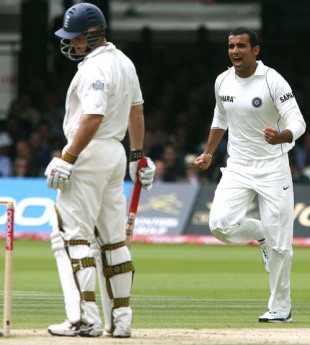Without him they will have to be cautious against England's swing bowlers. But even so the series, with its several mini-contests and the No. 1 ranking at stake, is expected to be a mouth-watering one
July 17, 2011

| |||
| Series/Tournaments: India tour of England | |||
Occasionally fate serves up a delightful twist to an already irresistible contest. The Lord's Test in particular, and the India versus England series in general, is one such example.
Coincidentally the game at Lord's is the 2000th Test match, and it launches a series where the No. 1 ranking is on the line.
It appears that fate has come down ever so slightly in England's favour. The first two venues in this series, Lord's and Trent Bridge, are known to favour swing bowling. England's ability to swing both the new and old ball is a big reason behind their recent rise up the rankings. In addition, India are missing their greatest counterattacking weapon.
There's no batsman in the world who can disrupt bowling plans quicker than Virender Sehwag, and he'll be missing for at least the first two Tests. India could dispute that reasoning by saying that they played without Sehwag the last time as well, in 2007, and won at Trent Bridge to clinch the series.
They should have also won at The Oval but Rahul Dravid, in a surprisingly timid captaincy move, failed to enforce the follow-on. In the recent series in the Caribbean, MS Dhoni was accused of being similarly cautious in the final Test - for not attempting a difficult chase to try and extend India's victory to 2-0.
In both cases the Indian captain had a series lead and was disinclined to allow the opposition even a sliver of a chance to level. The counter to that argument is that a captain doesn't get too many chances to win Test matches, so he should grab every one and shake the life out of that opportunity.
The one time a captain should not be overly cautious is at the start of a series, when a team can take a huge step towards mental superiority by being aggressive. This is where Sehwag's absence hurts India; being at the top of the order, he's likely to gain the upper hand in the series just by batting normally in the first session.
Consequently India will have to rely more on a wearing-down process to subdue the England swing bowlers, rather than on Sehwag's bludgeoning tactics. On the bowling side, India's biggest plus from the Caribbean series was the much-awaited return to form of Ishant Sharma.
In a frank interview the young fast bowler said he had tried to copy his opening partner, Zaheer Khan, and this had brought problems. Having rectified that mistake he's now poised to form a lethal combination with Zaheer, who is the Indian bowler best equipped to utilise any swing on offer.
Zaheer has the added advantage of being the type of bowler who troubles England captain Andrew Strauss. If India can separate Strauss and Alastair Cook quickly, the England batting is vulnerable. Cook's consistent high-scoring was crucial in England retaining the Ashes against Australia.
England are also vulnerable against good spin bowling, and the best way to expose this flaw is to make early inroads. This frailty also presents India with a selection poser: do they pick two spinners or three seamers? If they choose three seamers, will they prefer Yuvraj Singh to Suresh Raina? Yuvraj's recent bowling renaissance in ODIs makes his selection enticing, as Kevin Pietersen has shown that left-arm orthodox spinners are his kryptonite.
However, India should pick the best batsman at No. 6, and also give serious consideration to playing Amit Mishra at some stage during the series. Given slightly helpful conditions the steady legspinner could expose the English batsmen's leaden-footed approach to playing tweakers.
In addition to the battles already mentioned there will be many other absorbing contests. Harbhajan Singh against England's two left-handed openers. Jimmy Anderson, the best swing bowler in the game when he's on song, will test India's ageing middle-order, never mind the less experienced opening combination.
And then there's Graeme Swann, a fine attacking offspinner operating against batsmen who are most comfortable playing spin. There's a lot to look forward to in this series even before the No. 1 ranking is decided.


No comments:
Post a Comment